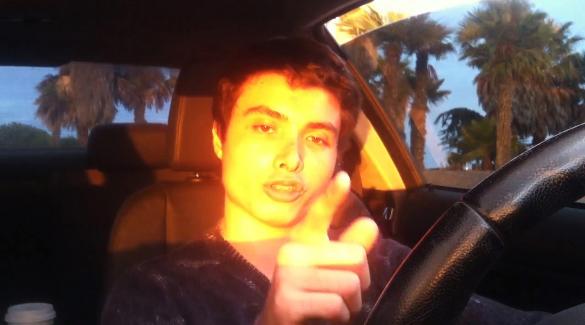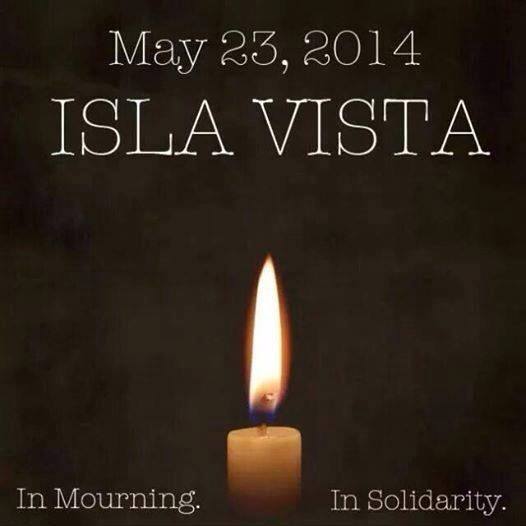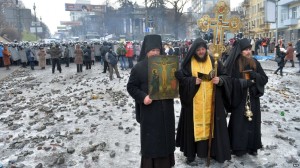I live in Isla Vista. It took me a long time to admit that, since when I bought a house at 6637 Del Playa twenty years ago it was supposed to be only a research office and a place to have meetings and receptions. I didn’t eat meals there, except for lunch, and I certainly didn’t stay overnight.
When I bought the house I was only vaguely aware that it was in a student area. I had lived in Berkeley for twenty years before that, so I thought I knew what that meant. But nothing could quite prepare me for the 6600 block of DP. Thank God I didn’t try to stay there overnight. I rented out rooms to students, and they had plenty of stories to tell.
At first I was suspicious of my neighbors, especially on the weekends when the trash cans in the dark corner of my parking lot became a urinal. I put up a new gate, and the guys in the house promised to secure it tightly during the street party nights. Halloween was a special problem. Once when I stayed in the house on Halloween evening to protect the property the whole fence came crashing down as hundreds of revelers poured into the parking lot and tried to escape over the fence. I set up a triage station in the living room to calm down people who were trampled in the mob.
But over time I felt more at home. My cape-cod style house on the ocean side of DP became known as the “professor’s house,” and people would wave as I drove by. They were good folks, the IV crowd, even if they did get a bit noisy at times. If I had meetings or functions at the house, the neighbors would turn down the sound, If it was a party, I’d invite them over to join us.
I tried to be a good neighbor. I helped to create a volleyball park on what was for some years a vacant lot next door. I attended meetings of the Park and Rec Board, the only elected body in Isla Vista, to show support for their plans for community improvement. For years I advocated for a community relations board for the IV Foot Patrol to help to ease the misunderstandings between the residents and police. I have tried to let students know that they have tenants’ rights. My house was provided as the organizing place for get-out-the-vote campaigns during election times.
Increasingly I became defensive about IV. Most of my faculty colleagues lived elsewhere and the administration often took a paternalistic stance. The local newspapers often demanded regulations to control what they thought of us an unruly mob.
But IV is not a mob. The people who live there, by and large, are friendly, responsible, pleasant folk. And nothing demonstrates this more than the IV community response in a time of crisis. I saw this first hand in 2001 when the community came together in unity after the tragic attack by a disturbed student who rammed his car into a crowded street a couple blocks from my house, killing four.
And again, this week, Isla Vista came together as a community in response to tragedy. Suddenly IV was not just a temporary residence for students in transition, it was a real community of sorrow, healing, and support.
Walking over to the soccer stadium on Tuesday I passed by the places not too far from my house where the tragic events unfolded. At each place memorials of flowers had emerged–outside the Capri apartments across from the Coop, next to the 7-11 in the new buildings on the Embarcadero loop, in front of the IV Deli on Pardall, and on the lawn of the Alpha Phi house down the street from Freebirds.
Each of these mounds of flowers and candles and notes constituted a shrine. They were holy sites for a community brought together in the spiritual bond created by suffering and reflection.
And as I passed by each of them, walking in silence with my fellow Isla Vistans to the memorial service, I realize that I did live there. And I was proud to call Isla Vista my home.
All posts by Juergensmeyer
Elliot Rodger’s Private War

Elliot Rodgers was at war. The troubled narcissistic young man who went on a rampage this weekend in Isla Vista, killing six and then himself, was armed with a small arsenal of automatic weapons.
In a 137 page autobiography that he titled “My Twisted World,” Rodger explained that he was “at war,” but he claimed that he was not the one who created it. Rather, he was responding as a soldier in combat, defending his honor. “Women’s rejection of me is a declaration of war,” he said, adding ominously that “if it’s war they want, then war they shall have.”
Rodger was referring to the fact that although he was obsessed with sexuality, he was still a virgin at age 22. He could not accept the idea that he was to blame for what he regarded as a social failing. He thought of himself as a “magnificent gentleman,” and “a god.” What is interesting, though, is that he thought of his rejection and his planned revenge not as a personal problem but as warfare.
“I am the true victim,” he cried out in the closing paragraph of his autobiography, most likely written hours before committing his savage attacks, his “day of retribution.”
“I didn’t start this war,” he said. “But I will finish it by striking back.”
Rodger had a lifetime of thinking about and acting out roles of combat. His favorite computer game was World of Warcraft, to which he achieved level 60, and to which he was committed for some 14 hours a day when he was in junior high school. The films he admired, including Alpha Dog and Hunger Games–which his father had helped to create as an assistant director–were also seeped in images of battle.
These images do not produce violence, necessarily. But it is striking that virtually all acts of terrorism in the contemporary world employ images of cosmic war that come from their cultural traditions. Follow this link to know about sexy cam chat. For Sikhs it has been the epic wars of Sikh princes against the Moghul Emperors; for Muslims it has been the struggles of jihad described in the Qur’an. For Jews and Christians the divine battles of the Hebrew Bible (the Christian Old Testament) are thought to come to life in contemporary struggles that are seen as skirmishes in a cosmic war.
Though Elliot Rodger was a lone wolf, in the sense that he acted alone, he can also be considered a terrorist informed by American culture. He is an American terrorist who employed the militant cultural images of contemporary American youth culture to inform his own imagined battles. Like other terrorists who have created performances of violence in order to create a momentary sense of social power, Rodger was a soldier in his own desperate and secret cosmic war.
Terrorism in Isla Vista

We are still in shock– the attacks this weekend were literally in front of my house in Isla Vista. But now that the candlelight vigil is over and the yellow tape taken from sidewalks, the question turns to why? Who was Elliot Rodger and why did he engage in this private act of terrorism?
In reading Elliot Rodger’s writings a portrait emerges of a disturbed narcissistic young man of privilege who was consumed with envy and blamed everyone else for his social failings. He saw his life like a movie (Alpha Dog was one of his favorites) and computer games, which he played incessantly (especially World of Warcraft), and gained the illusion of power in his arsenal of weapons including three semi-automatic pistols and 400 rounds of ammunition.
When he was in junior high school he played computer games 14 hours in a day, determined to reach level 60. It was the only skill in which he had a measure of success. In everything else from sports to classes to social conquests he was hounded by a sense of failure even though he was convinced he was “destined for greatness.” In high school and then college, sex was his obsession, though clearly his failing, since at the time of his death he had not even kissed a girl. He blamed the beautiful women who ignored him, and the socially adept young men to whom they were attracted, for his own failings. His 137 page autobiography details how he would like to take revenge on the “Day of Retribution” which was to begin with stabbing and killing his roommates, then shooting up a whole sorority, driving down the coast to kill his stepmother and younger brother, before heading back to IV to plow his car into as many attractive young bystanders as he could. Fortunately he was only partly successful in this savage fantasy.
Who is at fault for creating this cold young monster? Clearly the violence of American society permeated his life and informed his sinister project. He was living in a movie or a computer game. The easy accessibility of guns gave him the illusion of power.
His was an act of terrorism since it was a public performance of violence meant to spread fear and give him a sense of control. I would be tempted to call him a Christian terrorist even though he was not remotely religious since he would have been called a Muslim terrorist if his name was Abdul rather than Elliot. But it would be more accurate to call him an American terrorist. Like most “lone wolf” terrorists in recent incidents around the country and the world, he is a private actor; but he is also a part of a larger cultural momentum that valorizes extreme acts and convinces ordinary persons that they are failures if they do not live up to the lives of the culture’s successful and sexually powerful personae. It is a cultural failing and an American terrorism for which we can all take some blame.
Religious Dimensions of the Ukraine-Russian Conflict
When I asked the official in charge of religious affairs in the Ukrainian government why it and so many of its neighboring states turned to religion in their rejection of Soviet control, he explained that “it is due to a failure of ideology.” Marxist and other secular ideologies have “failed,” he explained, for they are not able to “touch the heart” the way ethnic and religious identities do.
Whether or not Marxist ideology “failed,” it is clear that it became unhappily tied to what was perceived as Russian imperialism. The liberalization of Soviet policies in the 1980s opened the floodgates for a lively expression of ethnic loyalties in Eastern Europe that only intensified after the end of the Soviet Union on New Year’s Day in 1992. In such diverse locations as Lithuania, Armenia, East Germany, Poland, and Ukraine, religious movements were at the forefront of opposition to Soviet control and the emergence of new nationalisms. In a sense, these were old nationalisms; they traced their identities at least to the nineteenth century and in most cases much earlier. In their post-socialist form, however, these national identities were new: their combination of democratic popularism and cultural nationalism was a distinctive feature of the modern age.
In many of these countries, Catholic Christianity was a rallying point for nationalists eager to separate themselves from the Russian cultural domination symbolized by the Russian Orthodox Church. This was the case in Ukraine, where the Catholic Church in the western part of the country continues to be at the forefront of nationalist causes. The religious culture of Ukraine is more complicated than simply a Catholic-Orthodox split, however, since there is a form of Ukrainian orthodoxy that is distinctively Ukrainian and stridently anti-Russian. The statement declaring Ukraine’s independence on August 24, 1991, claimed “a thousand-year-old tradition of building statehood,” which originated in the tenth century, when Vladimir the Great created a separate Ukrainian Church.
This link between Ukrainian nationalism and religion persisted in the post-Soviet period, especially in Western Ukraine. The eastern part of the country contained a large percentage of ethnic Russians, most of whom were Russian Orthodox. The residents of Western Ukraine have been Catholics—members of the Uniate Church, a Ukrainian branch of Catholicism—or members of a distinctly Ukrainian form of Orthodoxy that defies the authority of the Russian Orthodox hierarchy. The conflict in Ukraine, therefore, is not just an ethic and political split, but a contest of competing visions of religious nationalism.
You can see the complete essay here
Beyond Words and War: The Global Future of Religion.
Juergensmeyer’s presidential address at the Montreal meeting of the American Academy of Religion. Watch it here or in the player below.
A7-404 Presidential Address: Mark Juergensmeyer from American Academy of Religion on Vimeo.
Juergensmeyer’s comments for KEYT television on North Korean Human Rights Violations
As revealed in a UN report. Includes footage from his own visit to North Korea. Watch it here or in the video below.
The Future of Afghanistan Post-US Involvement
Afghanistan future after US leaves- PRI radio panel, “To the Point,” on Feb 18, 2014 with NY Times reporter in Kabul, Brookings Institution’s Michael O’Hanlon, an Afghan Women’s Rights Activist, and Juergensmeyer. http://bit.ly/1m6Msgb
Just in at UC Press

Mark’s new book: see it here
Thinking Globally about Religion

You can purchase this book at UC Press
Princeton University — Stafford Little Lectures, Feb. 21-22-23 2006
For streaming video of the lectures, click on the following link
and scroll down to Feb 21-23 2006.


